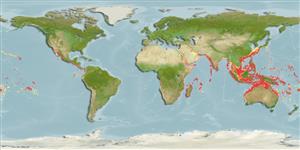Common names from other countries
>
Mulliformes (Goatfishes) >
Mullidae (Goatfishes)
Etymology: Parupeneus: Latin, parum, parvum = small + Peneus, the name of a river.
More on author: Lacepède.
Environment: milieu / climate zone / depth range / distribution range
Ökologie
seewasser; brackwasser riff-verbunden; tiefenbereich 12 - 350 m (Ref. 37816), usually ? - 60 m (Ref. 1602). Tropical; 35°N - 33°S
Indo-West Pacific: Red Sea and east coast of Africa to the Caroline Islands and Fiji.
Size / Gewicht / Alter
Maturity: Lm ? range ? - ? cm
Max length : 36.0 cm TL Männchen/unbestimmt; (Ref. 11441); common length : 25.0 cm TL Männchen/unbestimmt; (Ref. 9947); max. veröff. Gewicht: 877.00 g (Ref. 125599); max. veröff. Alter: 6 Jahre (Ref. 86367)
Rückenflossenstacheln (insgesamt): 8; Rückenflossenweichstrahlen (insgesamt): 9; Afterflossenstacheln 1; Afterflossenweichstrahlen: 7. Diagnosis: Pectoral rays 16 (rarely 15 or 17). Gill rakers 6-7 + 29-23 (total 26-30). Body depth 2.95-3.55 in SL; head length (HL) 2.9-3.25 in SL; snout length 1.75-2.1 in HL; barbel length 1.15-1.35 in HL; posterior end of maxilla evenly convex; longest dorsal spine 1.45-1.75 in HL; penultimate dorsal ray 1.05-1.25 in length of last dorsal ray; pectoral-fin length 1.25-1.4 in HL; pelvic-fin length 1.4-1.6 in HL. Body brownish yellow to light red (deeper-dwelling fish more red), the edges of the scales darker, shading to silvery white ventrally; adults with a small reddish brown spot on upper side of body just below seventh and eighth lateral-line scales; an indistinct narrow yellow stripe often visible above the lateral line (more evident in juveniles and subadults); dorsal body scales often with a pale blue or pearly spot; faint iridescent blue lines extending dorsoposteriorly and ventroanteriorly from eye, and often a parallel one on the cheek below eye; second dorsal and anal fins with faint pale blue or pink narrow bands alternating with pale yellow. Although Gloerfelt-Tarp and Kailola (1984: 213) reported that this species (as Parupeneus pleurospilus) has a dark brown peritoneum, the Bishop Museum specimens have a pale peritoneum (Ref. 54393).
Occurs singly or in small groups, over muddy, sandy, rubble, or seagrass bottoms of lagoon and seaward reefs, usually below 20 m. Flesh is fairly good for human consumption (Ref. 6023, 41878).
Life cycle and mating behavior
Geschlechtsreife | Fortpflanzung | Ablaichen | Eier | Fecundity | Larven
Randall, J.E., 2004. Revision of the goatfish genus Parupeneus (Perciformes: Mullidae), with descriptions of two new species. Indo-Pac. Fish. (36):64 p. (Ref. 54393)
IUCN Rote Liste Status (Ref. 130435)
CITES (Ref. 128078)
Not Evaluated
Bedrohung für Menschen
Harmless
Nutzung durch Menschen
Fischereien: kommerziell
Mehr Information
NamenSynonymeMetabolismusRäuberÖkotoxikologieFortpflanzungGeschlechtsreifeAblaichenFecundityEierEientwicklung
ReferenzenAquakulturAquakultur ProfilZuchtlinienGenetikElectrophoresesVererbbarkeitKrankheitenVerarbeitungMass conversion
Tools
Zusatzinformationen
Download XML
Internet Quellen
Estimates based on models
Preferred temperature (Ref.
115969): 23.2 - 28.1, mean 27.2 (based on 183 cells).
Phylogenetic diversity index (Ref.
82804): PD
50 = 0.5000 [Uniqueness, from 0.5 = low to 2.0 = high].
Bayesian length-weight: a=0.01175 (0.00969 - 0.01425), b=3.10 (3.07 - 3.13), in cm Total Length, based on LWR estimates for this species (Ref.
93245).
Trophic level (Ref.
69278): 3.4 ±0.0 se; based on diet studies.
Widerstandsfähigkeit (Ref.
120179): hoch, Verdopplung der Population dauert weniger als 15 Monate. (K=0.21-0.4).
Fishing Vulnerability (Ref.
59153): Moderate vulnerability (38 of 100).
